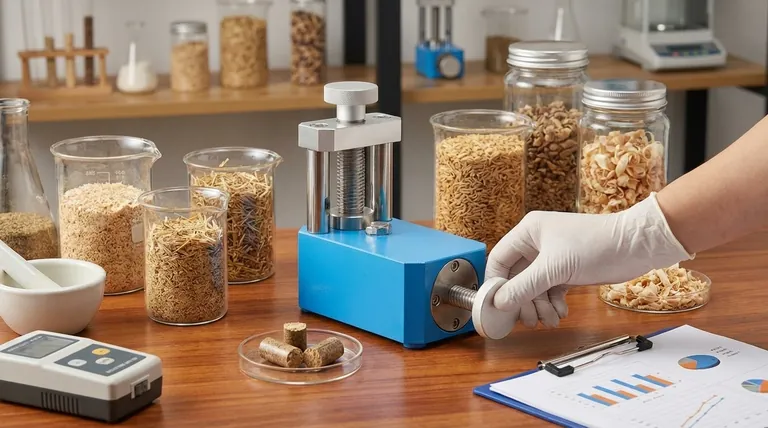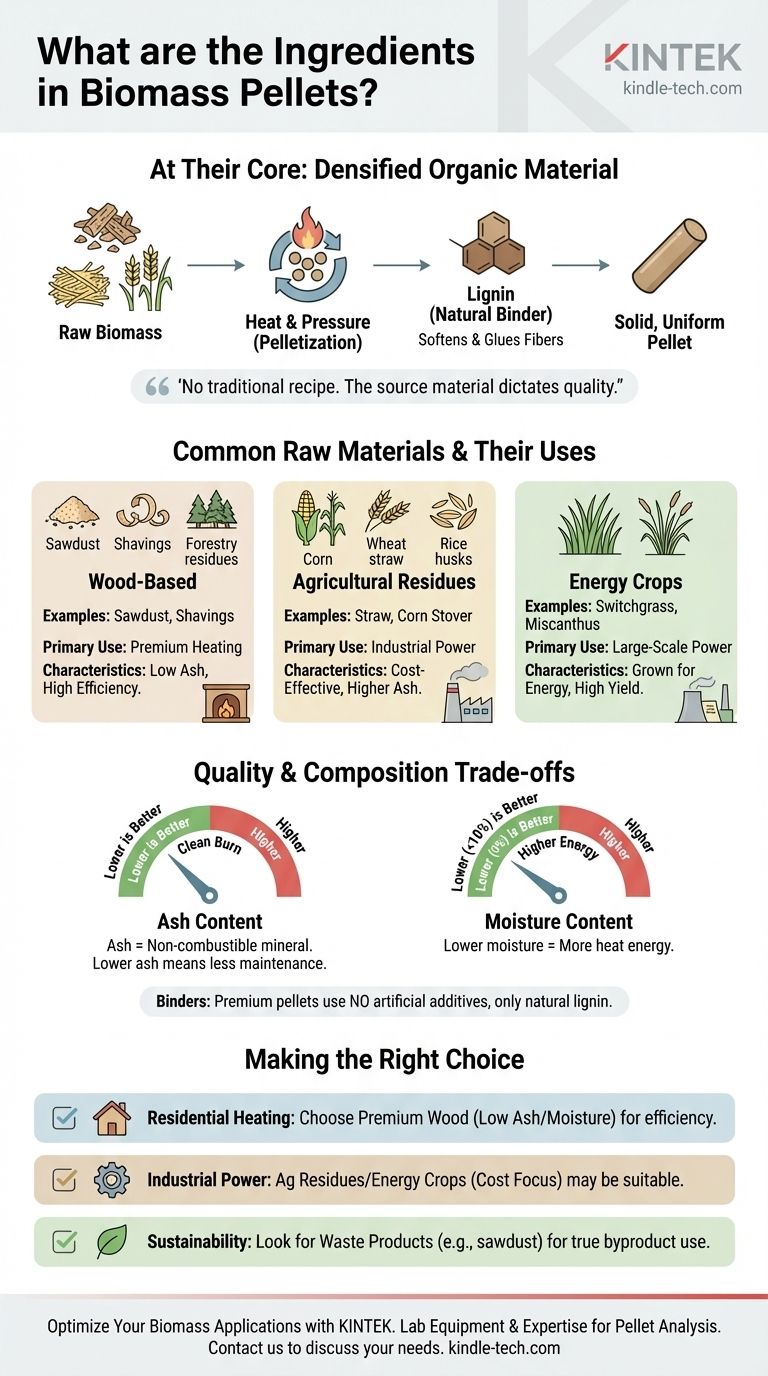At their core, biomass pellets are not made with a recipe of ingredients in the traditional sense. Instead, they are composed of densified raw organic material, most commonly wood or agricultural waste. The material is finely ground, dried, and then forced under extreme heat and pressure, which causes the natural lignin within the plant fibers to act as a binder, creating a solid, uniform pellet without the need for synthetic glues.
The specific type of organic material—the "ingredient"—is the single most important factor determining a pellet's quality. This choice dictates its energy output, ash content, and overall performance, making the source material far more critical than any additive.

The Core Component: Understanding Biomass
What is Biomass?
Biomass is simply organic matter derived from living, or recently living, organisms. In the context of pellets, this almost always refers to plant-based materials.
These materials are renewable resources, which is central to their appeal as an alternative to fossil fuels. The process concentrates the energy stored in this organic matter into a dense, manageable form.
The Role of Natural Lignin
The key to pellet formation is lignin, a complex polymer found in the cell walls of plants. It acts as a natural thermosetting plastic.
When raw biomass is subjected to intense pressure and heat (a process called pelletization), the lignin softens and acts as a glue. As the pellet cools, the lignin hardens, binding the ground material into its characteristic dense, cylindrical shape. This is why high-quality pellets require no artificial additives.
Common Raw Materials in Biomass Pellets
Wood-Based Materials
Wood is the most prevalent raw material for biomass pellets, particularly those used for residential heating. These are often referred to simply as "wood pellets."
Sources include sawdust and shavings from mills, forestry residues, and low-grade roundwood. Pellets are often classified as hardwood (denser, longer burn time) or softwood (higher heat output, but burn faster).
Agricultural Residues
A wide variety of agricultural byproducts can be used to create biomass pellets, especially for industrial applications where cost is a primary driver.
Common examples include corn stover (stalks and leaves), wheat straw, sugarcane bagasse, and rice husks. These materials are abundant but can have different combustion properties than wood.
Energy Crops
In some regions, crops are grown specifically for the purpose of energy production. These "energy crops" are selected for their high yield and low input requirements.
Switchgrass, miscanthus, and fast-growing poplar trees are common examples. Pellets from these sources are typically used in commercial or utility-scale power plants.
Understanding the Trade-offs: Quality and Composition
The raw material used directly impacts the final quality of the pellet. Understanding these differences is crucial for choosing the right product for your needs.
Ash Content is Key
Ash is the non-combustible mineral content left after the pellet is burned. A lower ash content is highly desirable, as it means more efficient burning and less maintenance for your appliance.
Generally, clean wood (with no bark) produces the lowest ash. Agricultural residues like straw often have significantly higher ash content due to minerals absorbed from the soil.
Moisture Content Drives Energy Output
The heating value of a pellet is directly related to its moisture content. The pelletizing process involves drying the raw material, typically to a moisture level below 10%.
The lower the moisture, the more energy is available for heat rather than being wasted to evaporate water. This is a critical quality standard for all pellet types.
Binders and Additives
Premium wood pellets for residential heating should not contain any binders or additives. The natural lignin is sufficient.
In some industrial processes involving low-lignin materials (like certain agricultural residues), a small percentage of a binding agent like starch may be added to ensure pellet durability. However, this is not standard for high-grade pellets.
Making the Right Choice for Your Goal
Ultimately, the best "ingredient" depends entirely on your application.
- If your primary focus is residential heating: Choose premium-grade wood pellets certified for low ash and low moisture content to ensure maximum efficiency and minimal cleaning.
- If your primary focus is industrial power generation: A wider range of agricultural residues or energy crops may be suitable, where the lower cost of raw materials can offset the challenges of higher ash content.
- If your primary focus is sustainability: Look for pellets made from waste products, such as sawdust from furniture manufacturing or sustainably managed forestry residues, to ensure you are using a true byproduct.
Understanding the origin of your biomass pellets empowers you to make an informed decision based on performance, cost, and environmental impact.
Summary Table:
| Key Ingredient Type | Common Examples | Primary Use & Characteristics |
|---|---|---|
| Wood-Based | Sawdust, wood shavings, forestry residues | Premium heating pellets; low ash, high efficiency |
| Agricultural Residues | Straw, corn stover, rice husks | Industrial power generation; cost-effective, higher ash |
| Energy Crops | Switchgrass, miscanthus | Grown for energy; used in large-scale power plants |
Choose the Right Biomass Pellets for Your Lab or Production Needs
Understanding pellet composition is critical for achieving consistent results, whether you're conducting research, testing materials, or optimizing an industrial process. The raw material directly impacts combustion efficiency, ash behavior, and equipment performance.
KINTEK specializes in lab equipment and consumables, serving laboratories that analyze, develop, or utilize biomass pellets. We provide the tools and expertise to help you test pellet quality, analyze composition, and ensure your processes run smoothly.
Let us help you optimize your biomass applications—contact our experts today to discuss your specific requirements!
Visual Guide

Related Products
- kbr pellet press 2t
- Custom PTFE Teflon Parts Manufacturer for PTFE Buchner Funnel and Triangular Funnel
- Custom PTFE Teflon Parts Manufacturer for PTFE Mesh F4 Sieve
- Vacuum Sealed Continuous Working Rotary Tube Furnace Rotating Tube Furnace
- Custom PTFE Teflon Parts Manufacturer PTFE Beaker and Lids
People Also Ask
- How do you prepare samples for infrared spectroscopy? Master Solid, Liquid & Gas Techniques
- Why KBr is used for IR spectroscopy? The Ideal Medium for Solid Sample Analysis
- What is KBr disc method in IR spectroscopy? A Guide to Solid Sample Analysis
- What are the different types of sampling techniques used in IR spectroscopy? A Guide to KBr, Mull, and ATR Methods
- What is a KBr pellet? A Guide to Preparing Solid Samples for IR Spectroscopy






